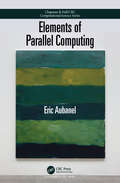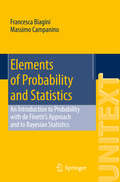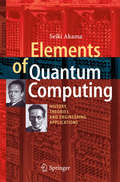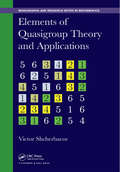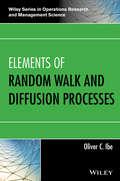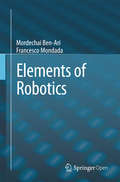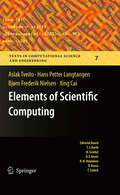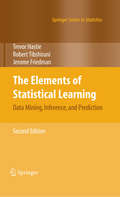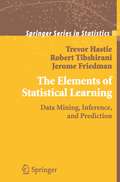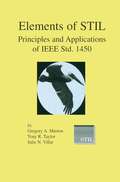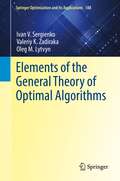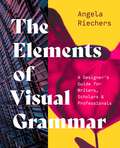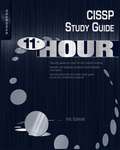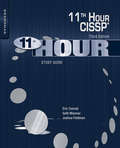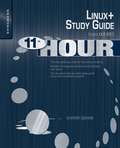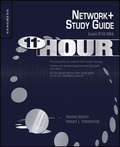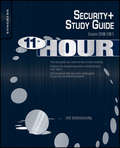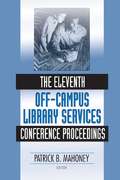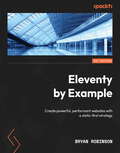- Table View
- List View
Elements of Parallel Computing (Chapman & Hall/CRC Computational Science)
by Eric AubanelDesigned for introductory parallel computing courses at the advanced undergraduate or beginning graduate level, Elements of Parallel Computing presents the fundamental concepts of parallel computing not from the point of view of hardware, but from a more abstract view of algorithmic and implementation patterns. The aim is to facilitate the teaching of parallel programming by surveying some key algorithmic structures and programming models, together with an abstract representation of the underlying hardware. The presentation is friendly and informal. The content of the book is language neutral, using pseudocode that represents common programming language models. The first five chapters present core concepts in parallel computing. SIMD, shared memory, and distributed memory machine models are covered, along with a brief discussion of what their execution models look like. The book also discusses decomposition as a fundamental activity in parallel algorithmic design, starting with a naive example, and continuing with a discussion of some key algorithmic structures. Important programming models are presented in depth, as well as important concepts of performance analysis, including work-depth analysis of task graphs, communication analysis of distributed memory algorithms, key performance metrics, and a discussion of barriers to obtaining good performance. The second part of the book presents three case studies that reinforce the concepts of the earlier chapters. One feature of these chapters is to contrast different solutions to the same problem, using select problems that aren't discussed frequently in parallel computing textbooks. They include the Single Source Shortest Path Problem, the Eikonal equation, and a classical computational geometry problem: computation of the two-dimensional convex hull. After presenting the problem and sequential algorithms, each chapter first discusses the sources of parallelism then surveys parallel algorithms.
The Elements of Photography: Understanding and Creating Sophisticated Images
by Angela Faris BeltThe greatly revised and expanded edition of The Elements of Photography is a new kind of textbook for a new generation of photographers. Moving far beyond the usual technical manual, Angela Faris Belt dives deep into merging technique and vision, allowing you to master craft while adding meaning to your images. Here you'll really learn to see photographically, expand your creative and conceptual use of apertures and shutter speeds, and choose the right media to create the look and feel you want.
The Elements of Photography: Understanding and Creating Sophisticated Images
by Angela Faris BeltThe greatly revised and expanded edition of The Elements of Photography is a new kind of textbook for a new generation of photographers. Moving far beyond the usual technical manual, Angela Faris Belt dives deep into merging technique and vision, allowing you to master craft while adding meaning to your images. Here you'll really learn to see photographically, expand your creative and conceptual use of apertures and shutter speeds, and choose the right media to create the look and feel you want.
Elements of Probability and Statistics: An Introduction to Probability with de Finetti’s Approach and to Bayesian Statistics (UNITEXT #98)
by Francesca Biagini Massimo CampaninoThis book provides an introduction to elementary probability and to Bayesian statistics using de Finetti's subjectivist approach. One of the features of this approach is that it does not require the introduction of sample space – a non-intrinsic concept that makes the treatment of elementary probability unnecessarily complicate – but introduces as fundamental the concept of random numbers directly related to their interpretation in applications. Events become a particular case of random numbers and probability a particular case of expectation when it is applied to events. The subjective evaluation of expectation and of conditional expectation is based on an economic choice of an acceptable bet or penalty. The properties of expectation and conditional expectation are derived by applying a coherence criterion that the evaluation has to follow. The book is suitable for all introductory courses in probability and statistics for students in Mathematics, Informatics, Engineering, and Physics.
Elements of Quantum Computing: History, Theories and Engineering Applications
by Seiki AkamaA quantum computer is a computer based on a computational model which uses quantum mechanics, which is a subfield of physics to study phenomena at the micro level. There has been a growing interest on quantum computing in the 1990's and some quantum computers at the experimental level were recently implemented. Quantum computers enable super-speed computation and can solve some important problems whose solutions were regarded impossible or intractable with traditional computers.This book provides a quick introduction to quantum computing for readers who have no backgrounds of both theory of computation and quantum mechanics. “Elements of Quantum Computing” presents the history, theories and engineering applications of quantum computing. The book is suitable to computer scientists, physicists and software engineers.
Elements of Quasigroup Theory and Applications (Chapman & Hall/CRC Monographs and Research Notes in Mathematics)
by Victor ShcherbacovThis book provides an introduction to quasigroup theory along with new structural results on some of the quasigroup classes. Many results are presented with some of them from mathematicians of the former USSR. These included results have not been published before in the western mathematical literature. In addition, many of the achievements obtained with regard to applications of quasigroups in coding theory and cryptology are described.
Elements of Random Walk and Diffusion Processes (Wiley Series in Operations Research and Management Science)
by Oliver C. IbePresents an important and unique introduction to random walk theory Random walk is a stochastic process that has proven to be a useful model in understanding discrete-state discrete-time processes across a wide spectrum of scientific disciplines. Elements of Random Walk and Diffusion Processes provides an interdisciplinary approach by including numerous practical examples and exercises with real-world applications in operations research, economics, engineering, and physics. Featuring an introduction to powerful and general techniques that are used in the application of physical and dynamic processes, the book presents the connections between diffusion equations and random motion. Standard methods and applications of Brownian motion are addressed in addition to Levy motion, which has become popular in random searches in a variety of fields. The book also covers fractional calculus and introduces percolation theory and its relationship to diffusion processes. With a strong emphasis on the relationship between random walk theory and diffusion processes, Elements of Random Walk and Diffusion Processes features: Basic concepts in probability, an overview of stochastic and fractional processes, and elements of graph theory Numerous practical applications of random walk across various disciplines, including how to model stock prices and gambling, describe the statistical properties of genetic drift, and simplify the random movement of molecules in liquids and gases Examples of the real-world applicability of random walk such as node movement and node failure in wireless networking, the size of the Web in computer science, and polymers in physics Plentiful examples and exercises throughout that illustrate the solution of many practical problems Elements of Random Walk and Diffusion Processes is an ideal reference for researchers and professionals involved in operations research, economics, engineering, mathematics, and physics. The book is also an excellent textbook for upper-undergraduate and graduate level courses in probability and stochastic processes, stochastic models, random motion and Brownian theory, random walk theory, and diffusion process techniques.
Elements of Random Walk and Diffusion Processes (Wiley Series in Operations Research and Management Science)
by Oliver C. IbePresents an important and unique introduction to random walk theory Random walk is a stochastic process that has proven to be a useful model in understanding discrete-state discrete-time processes across a wide spectrum of scientific disciplines. Elements of Random Walk and Diffusion Processes provides an interdisciplinary approach by including numerous practical examples and exercises with real-world applications in operations research, economics, engineering, and physics. Featuring an introduction to powerful and general techniques that are used in the application of physical and dynamic processes, the book presents the connections between diffusion equations and random motion. Standard methods and applications of Brownian motion are addressed in addition to Levy motion, which has become popular in random searches in a variety of fields. The book also covers fractional calculus and introduces percolation theory and its relationship to diffusion processes. With a strong emphasis on the relationship between random walk theory and diffusion processes, Elements of Random Walk and Diffusion Processes features: Basic concepts in probability, an overview of stochastic and fractional processes, and elements of graph theory Numerous practical applications of random walk across various disciplines, including how to model stock prices and gambling, describe the statistical properties of genetic drift, and simplify the random movement of molecules in liquids and gases Examples of the real-world applicability of random walk such as node movement and node failure in wireless networking, the size of the Web in computer science, and polymers in physics Plentiful examples and exercises throughout that illustrate the solution of many practical problems Elements of Random Walk and Diffusion Processes is an ideal reference for researchers and professionals involved in operations research, economics, engineering, mathematics, and physics. The book is also an excellent textbook for upper-undergraduate and graduate level courses in probability and stochastic processes, stochastic models, random motion and Brownian theory, random walk theory, and diffusion process techniques.
Elements of Robotics
by Mordechai Ben-Ari Francesco MondadaThis open access book bridges the gap between playing with robots in school and studying robotics at the upper undergraduate and graduate levels to prepare for careers in industry and research. Robotic algorithms are presented formally, but using only mathematics known by high-school and first-year college students, such as calculus, matrices and probability. Concepts and algorithms are explained through detailed diagrams and calculations.Elements of Robotics presents an overview of different types of robots and the components used to build robots, but focuses on robotic algorithms: simple algorithms like odometry and feedback control, as well as algorithms for advanced topics like localization, mapping, image processing, machine learning and swarm robotics. These algorithms are demonstrated in simplified contexts that enable detailed computations to be performed and feasible activities to be posed. Students who study these simplified demonstrations will be well prepared for advanced study of robotics.The algorithms are presented at a relatively abstract level, not tied to any specific robot. Instead a generic robot is defined that uses elements common to most educational robots: differential drive with two motors, proximity sensors and some method of displaying output to the user.The theory is supplemented with over 100 activities, most of which can be successfully implemented using inexpensive educational robots. Activities that require more computation can be programmed on a computer. Archives are available with suggested implementations for the Thymio robot and standalone programs in Python.
Elements of Scientific Computing (Texts in Computational Science and Engineering #7)
by Aslak Tveito Hans Petter Langtangen Bjørn Frederik Nielsen Xing CaiScience used to be experiments and theory, now it is experiments, theory and computations. The computational approach to understanding nature and technology is currently flowering in many fields such as physics, geophysics, astrophysics, chemistry, biology, and most engineering disciplines. This book is a gentle introduction to such computational methods where the techniques are explained through examples. It is our goal to teach principles and ideas that carry over from field to field. You will learn basic methods and how to implement them. In order to gain the most from this text, you will need prior knowledge of calculus, basic linear algebra and elementary programming.
The Elements of Statistical Learning: Data Mining, Inference, and Prediction, Second Edition (Springer Series in Statistics)
by Trevor Hastie Robert Tibshirani Jerome FriedmanThis book describes the important ideas in a variety of fields such as medicine, biology, finance, and marketing in a common conceptual framework. While the approach is statistical, the emphasis is on concepts rather than mathematics. Many examples are given, with a liberal use of colour graphics. It is a valuable resource for statisticians and anyone interested in data mining in science or industry. The book's coverage is broad, from supervised learning (prediction) to unsupervised learning. The many topics include neural networks, support vector machines, classification trees and boosting---the first comprehensive treatment of this topic in any book. This major new edition features many topics not covered in the original, including graphical models, random forests, ensemble methods, least angle regression & path algorithms for the lasso, non-negative matrix factorisation, and spectral clustering. There is also a chapter on methods for "wide'' data (p bigger than n), including multiple testing and false discovery rates.
The Elements of Statistical Learning: Data Mining, Inference, and Prediction (Springer Series in Statistics)
by Trevor Hastie Robert Tibshirani Jerome FriedmanDuring the past decade there has been an explosion in computation and information technology. With it have come vast amounts of data in a variety of fields such as medicine, biology, finance, and marketing. The challenge of understanding these data has led to the development of new tools in the field of statistics, and spawned new areas such as data mining, machine learning, and bioinformatics. Many of these tools have common underpinnings but are often expressed with different terminology. This book describes the important ideas in these areas in a common conceptual framework. While the approach is statistical, the emphasis is on concepts rather than mathematics. Many examples are given, with a liberal use of color graphics. It should be a valuable resource for statisticians and anyone interested in data mining in science or industry. The book’s coverage is broad, from supervised learning (prediction) to unsupervised learning. The many topics include neural networks, support vector machines, classification trees and boosting---the first comprehensive treatment of this topic in any book. This major new edition features many topics not covered in the original, including graphical models, random forests, ensemble methods, least angle regression & path algorithms for the lasso, non-negative matrix factorization, and spectral clustering. There is also a chapter on methods for “wide” data (p bigger than n), including multiple testing and false discovery rates. Trevor Hastie, Robert Tibshirani, and Jerome Friedman are professors of statistics at Stanford University. They are prominent researchers in this area: Hastie and Tibshirani developed generalized additive models and wrote a popular book of that title. Hastie co-developed much of the statistical modeling software and environment in R/S-PLUS and invented principal curves and surfaces. Tibshirani proposed the lasso and is co-author of the very successful An Introduction to the Bootstrap. Friedman is the co-inventor of many data-mining tools including CART, MARS, projection pursuit and gradient boosting.
Elements of STIL: Principles and Applications of IEEE Std. 1450 (Frontiers in Electronic Testing #24)
by Gregory A. Maston Tony R. Taylor Julie N. VillarStandard • Test In. terface ____________________ Language So I was wrong. I was absolutely sure that by having an IEEE Standard defined, reviewed, and accepted, that I wouldn't need to write a book about it as well. The Standard would be the complete reference. And be aware - this book does not serve as a replacement to the IEEE Std. 1450 document. You should have a copy of the Standard as you go through this book. I realized that the Standard would not be the complete reference, about the time that the Working Group started to put notes into the draft proposa- notes to elaborate decisions in the Working Group, but that would be removed in the final draft. Then, once the Standard was accepted I became the central point of contact for people who just picked up the Standard, who didn't have the benefit of the Working Group discussions, who only had available that one final sentence in the Standard and who didn't benefit from the perspective of where those words came from. Sometimes those questions have resulted in clarifications to the Standard. Sometimes I would respond to those questions with more background and perspective as well. It is this additional background and perspective I hope you find in this book.
Elements of the General Theory of Optimal Algorithms (Springer Optimization and Its Applications #188)
by Ivan V. Sergienko Valeriy K. Zadiraka Oleg M. LytvynIn this monograph, the authors develop a methodology that allows one to construct and substantiate optimal and suboptimal algorithms to solve problems in computational and applied mathematics. Throughout the book, the authors explore well-known and proposed algorithms with a view toward analyzing their quality and the range of their efficiency. The concept of the approach taken is based on several theories (of computations, of optimal algorithms, of interpolation, interlination, and interflatation of functions, to name several). Theoretical principles and practical aspects of testing the quality of algorithms and applied software, are a major component of the exposition. The computer technology in construction of T-efficient algorithms for computing ε-solutions to problems of computational and applied mathematics, is also explored. The readership for this monograph is aimed at scientists, postgraduate students, advanced students, and specialists dealing with issues of developing algorithmic and software support for the solution of problems of computational and applied mathematics.
The Elements of Visual Grammar: A Designer's Guide for Writers, Scholars, and Professionals (Skills For Scholars Ser.)
by Angela RiechersA color-illustrated introduction to the basic principles of visual language that every content creator and consumer needs to knowThe right images capture attention, pique curiosity, and inspire viewers to stick around long enough to read any accompanying text. Nearly everyone today needs to use or understand images in communications of all kinds, from the most formal professional publication to the most casual social media post, and knowing the basics of visual language is essential for content creators and consumers alike. However, most people aren’t taught visual grammar unless they go into art- or design-related fields. The Elements of Visual Grammar explains image use in any media in practical terms for writers, scholars, and other professionals. Award-winning art director and design professor Angela Riechers offers a flexible set of principles and best practices for selecting images that work—and using them in the most persuasive way. The result is an indispensable guide for anyone who wants to learn how to work more successfully with images and words.Features more than 200 color illustrations—drawn from a wide range of styles, media, and eras—that demonstrate the principles of visual grammar and how images can support and enhance written contentDefines and illustrates the basic elements of images, describes how images function within text regardless of media, and explains how to choose images and integrate them with textIntroduces the practical, cultural, conceptual, and scientific factors that influence image useAnalyzes images by function and describes ways to employ symbolism, synecdoche, allegory, metaphor, analogy, and iconography
The Elements of Visual Grammar: A Designer's Guide for Writers, Scholars, and Professionals (Skills For Scholars Ser.)
by Angela RiechersA color-illustrated introduction to the basic principles of visual language that every content creator and consumer needs to knowThe right images capture attention, pique curiosity, and inspire viewers to stick around long enough to read any accompanying text. Nearly everyone today needs to use or understand images in communications of all kinds, from the most formal professional publication to the most casual social media post, and knowing the basics of visual language is essential for content creators and consumers alike. However, most people aren’t taught visual grammar unless they go into art- or design-related fields. The Elements of Visual Grammar explains image use in any media in practical terms for writers, scholars, and other professionals. Award-winning art director and design professor Angela Riechers offers a flexible set of principles and best practices for selecting images that work—and using them in the most persuasive way. The result is an indispensable guide for anyone who wants to learn how to work more successfully with images and words.Features more than 200 color illustrations—drawn from a wide range of styles, media, and eras—that demonstrate the principles of visual grammar and how images can support and enhance written contentDefines and illustrates the basic elements of images, describes how images function within text regardless of media, and explains how to choose images and integrate them with textIntroduces the practical, cultural, conceptual, and scientific factors that influence image useAnalyzes images by function and describes ways to employ symbolism, synecdoche, allegory, metaphor, analogy, and iconography
Elevate SwiftUI Skills by Building Projects: Build four modern applications using Swift, Xcode 14, and SwiftUI for iPhone, iPad, Mac, and Apple Watch
by Frahaan HussainExplore the power of SwiftUI, creating complex user interfaces for different Apple platforms as you design a tax calculator app, a photo gallery app, an app store, and a fitness companion appKey FeaturesLearn how to use the latest SwiftUI features such as UIkitDevelop UIs for all categories of Apple devices, from the Apple Watch to the iPadEnhance your applications further with advanced SwiftUI featuresPurchase of the print or Kindle book includes a free PDF eBookBook DescriptionElevate SwiftUI Skills by Building Projects helps you harness the cutting-edge potential of SwiftUI and its innovative and user-friendly approach to crafting user interfaces for Apple platforms with the power of Swift. This book will enhance your UI programming skills with SwiftUI through a project-based methodology, guiding you to create four real-world projects. Starting with a quick recap of Swift and SwiftUI, you’ll gradually develop projects tailored for iPhone, iPad, macOS, and watchOS using Swift and Xcode. You’ll experience SwiftUI’s versatility in action as you build a tax calculator for iPhone and a photo gallery for the iPad, which uses a larger display to enhance the viewing experience. You’ll also create an app store for Mac and, finally, get to grips with the power of SwiftUI for smaller devices such as the Apple Watch by designing a Fitness Companion app. By the end of this book, you'll have built fully functional projects across multiple platforms and gained the expertise needed to excel as a professional SwiftUI developer.What you will learnStart with a quick recap of UI essentials in Swift and Swift basicsDiscover how UI elements are integrated into appsUnderstand how SwiftUI builds on top of the pre-existing Swift programming languageFamiliarize yourself with the latest Xcode version to create SwiftUI appsDevelop a wide variety of applications that can be used as cornerstonesDesign and code for watchOS, iOS, macOS, and iPadOS in SwiftUI through explicit projectsWho this book is forIf you are a mobile developer already well-versed in Apple development using Swift, this book will further advance your skills in UI design. Basic Swift, Xcode, and Apple OS knowledge will help you get the most out of this book.
Eleventh Hour CISSP: Study Guide
by Eric Conrad Seth Misenar Joshua FeldmanEleventh Hour CISSP Study Guide serves as a guide for those who want to be information security professionals. The main job of an information security professional is to evaluate the risks involved in securing assets and to find ways to mitigate those risks. Information security jobs include firewall engineers, penetration testers, auditors, and the like. The book is composed of 10 domains of the Common Body of Knowledge. In each section, it defines each domain. The first domain provides information about risk analysis and mitigation, and it discusses security governance. The second domain discusses techniques of access control, which is the basis for all security disciplines. The third domain explains the concepts behind cryptography, which is a secure way of communicating that is understood only by certain recipients. Domain 5 discusses security system design, which is fundamental in operating the system and software security components. Domain 6 is one of the critical domains in the Common Body of Knowledge, the Business Continuity Planning and Disaster Recovery Planning. It is the final control against extreme events such as injury, loss of life, or failure of an organization. Domain 7, Domain 8 and Domain 9 discuss telecommunications and network security, application development security, and the operations domain, respectively. Domain 10 focuses on the major legal systems that provide a framework for determining laws about information system.The only guide you need for last-minute studyingAnswers the toughest questions and highlights core topicsCan be paired with any other study guide so you are completely prepared
Eleventh Hour CISSP®: Study Guide
by Eric Conrad Seth Misenar Joshua FeldmanEleventh Hour CISSP: Study Guide, Third Edition provides readers with a study guide on the most current version of the Certified Information Systems Security Professional exam. This book is streamlined to include only core certification information, and is presented for ease of last-minute studying. Main objectives of the exam are covered concisely with key concepts highlighted. The CISSP certification is the most prestigious, globally-recognized, vendor neutral exam for information security professionals. Over 100,000 professionals are certified worldwide, with many more joining their ranks. This new third edition is aligned to cover all of the material in the most current version of the exam’s Common Body of Knowledge. All domains are covered as completely and concisely as possible, giving users the best possible chance of acing the exam.Completely updated for the most current version of the exam’s Common Body of KnowledgeProvides the only guide you need for last-minute studyingAnswers the toughest questions and highlights core topicsStreamlined for maximum efficiency of study, making it ideal for professionals updating their certification or for those taking the test for the first time
Eleventh Hour Linux+: Exam XK0-003 Study Guide
by Brian Barber Graham Speake Chris Happel Terrence V. LillardEleventh Hour Linux+: Exam XK0-003 Study Guide offers a practical guide for those preparing for the Linux+ certification exam. The book begins with a review of important concepts that are needed for successful operating system installation. These include computer hardware, environment settings, partitions, and network settings. The book presents the strategies for creating filesystems; different types of filesystems; the tools used to create filesystems; and the tools used to administer filesystems. It explains the Linux boot process; how to configure system and user profiles as well as the common environment variables; and how to use BASH command line interpreter. The remaining chapters discuss how to install, configure, support, and remove applications; the configuration of Linux as a workstation and as a server; securing the Linux system; and common tools for managing a system. Each chapter includes information on exam objectives, exam warnings, and the top five toughest questions along with their answers.Fast Facts quickly review fundamentalsExam Warnings highlight particularly tough sections of the examCrunch Time sidebars point out key concepts to rememberDid You Know? sidebars cover sometimes forgotten details Top Five Toughest Questions and answers help you to prepare
Eleventh Hour Network+: Exam N10-004 Study Guide
by Naomi AlpernEleventh Hour Security+: Exam SY0-201 Study Guide offers a practical guide for those preparing for the CompTIA Network+ exam. The book's 10 chapters provide in-depth discussions of the following topics: network fundamentals; network media; network devices; wireless networking; open systems interconnection (OSI) model and networking protocols; transmission control protocol/internet protocol (TCP/IP) and IP routing; wide area networking; hardware and software security; network management; and network troubleshooting. Each chapter includes information on exam objectives, exam warnings, and the top five toughest questions along with their answers.The only book keyed to the new 2009 objectives that has been crafted for last minute crammingEasy to find, essential material with no fluff – this book does not talk about security in general, just how it applies to the testIncludes review of five toughest questions by topic - sure to improve your score
Eleventh Hour Security+: Exam SY0-201 Study Guide
by Ido DubrawskyEleventh Hour Network+: Exam N10-004 Study Guide offers a practical guide for those preparing for the Security+ certification exam. The book's 14 chapters provide in-depth discussions of the following topics: systems security; operating system hardening; application security; virtualization technologies; network security; wireless networks; network access; network authentication; risk assessment and risk mitigation; general cryptographic concepts; public key infrastructure; redundancy planning; environmental controls and implementing disaster recovery and incident response procedures; and legislation and organizational policies. Each chapter includes information on exam objectives, exam warnings, and the top five toughest questions along with their answers.The only book keyed to the new SY0-201 objectives that has been crafted for last minute cramming Easy to find, essential material with no fluff – this book does not talk about security in general, just how it applies to the testIncludes review of five toughest questions by topic - sure to improve your score
The Eleventh Off-Campus Library Services Conference Proceedings
by Patrick MahoneyLearn how to provide better service to distance information users! This book is the result of the conference held in May, 2004 in Scottsdale, Arizona, focusing on librarians' challenges providing service to nontraditional faculty and students. Respected authorities discuss in detail specific problems-and fresh strategies and solutions-to further promote service to distance information users. Each chapter tackles a particular issue such as collaboration outside the contributor's organization or how services can be monitored and assessed to gauge quality, and fully explains what can be done to address those issues. Each distinguished contribution was carefully selected by a 26-member advisory board using a juried abstracts process. Thorough bibliographies, useful figures, tables, and graphs provide accessibility and clarify ideas. Some of the topics in this book include: the promotion of library services to Native American students the planning and development process of a project to create a Web-based multi-media instruction tool for off-campus graduate students an examination of direct linking tools provided by major aggregators distance learning for the learning disabled distance learning implementation strategies for institutions course management software (CMS) and library services integration a survey of Association of Research Libraries offered services the do&’s and don&’ts of videoconferencing on and off-campus an eBooks collection study one-on-one research coaching via digital reference service an online tool that assesses students&’ research skills and attitudes creating a library CD for off-campus students expanding student and faculty access to information services the collaboration with faculty on electronic course reserves developing assessment questions for services supporting off-campus learning programs providing secure off-campus access to library services beyond proxy servers and much, much more!The Eleventh Off-Campus Library Services Conference Proceedings is an invaluable comprehensive resource detailing the latest challenges and solutions for on- and off-campus librarians.
The Eleventh Off-Campus Library Services Conference Proceedings
by Patrick MahoneyLearn how to provide better service to distance information users! This book is the result of the conference held in May, 2004 in Scottsdale, Arizona, focusing on librarians' challenges providing service to nontraditional faculty and students. Respected authorities discuss in detail specific problems-and fresh strategies and solutions-to further promote service to distance information users. Each chapter tackles a particular issue such as collaboration outside the contributor's organization or how services can be monitored and assessed to gauge quality, and fully explains what can be done to address those issues. Each distinguished contribution was carefully selected by a 26-member advisory board using a juried abstracts process. Thorough bibliographies, useful figures, tables, and graphs provide accessibility and clarify ideas. Some of the topics in this book include: the promotion of library services to Native American students the planning and development process of a project to create a Web-based multi-media instruction tool for off-campus graduate students an examination of direct linking tools provided by major aggregators distance learning for the learning disabled distance learning implementation strategies for institutions course management software (CMS) and library services integration a survey of Association of Research Libraries offered services the do&’s and don&’ts of videoconferencing on and off-campus an eBooks collection study one-on-one research coaching via digital reference service an online tool that assesses students&’ research skills and attitudes creating a library CD for off-campus students expanding student and faculty access to information services the collaboration with faculty on electronic course reserves developing assessment questions for services supporting off-campus learning programs providing secure off-campus access to library services beyond proxy servers and much, much more!The Eleventh Off-Campus Library Services Conference Proceedings is an invaluable comprehensive resource detailing the latest challenges and solutions for on- and off-campus librarians.
Eleventy by Example: Create powerful, performant websites with a static-first strategy
by Bryan RobinsonBuild faster static sites by leveraging CDN and creating custom tools and workflows with 5 real-world projects Purchase of the print or Kindle book includes a free PDF eBookKey FeaturesLearn how to use and extend 11ty, one of the most flexible static site generators in the industry.Optimize your experience by customizing 11ty to suit various projects’ needsCreate request-time experiences without recreating templates with 11ty ServerlessBook Description11ty is the dark horse of the Jamstack world, offering unparalleled flexibility and performance that gives it an edge against other static site generators such as Jekyll and Hugo. With it, developers can leverage the complete Node ecosystem and create blazing-fast, static-first websites that can be deployed from a content delivery network or a simple server. This book will teach you how to set up, customize, and make the most of 11ty in no time. Eleventy by Example helps you uncover everything you need to create your first 11ty website before diving into making more complex sites and extending 11ty’s base functionality with custom short codes, plugins, and content types. Over the course of 5 interactive projects, you’ll learn how to build basic websites, blogs, media sites, and static sites that will respond to user input without the need for a server. With these, you’ll learn basic 11ty skills such as templates, collections, and data use, along with advanced skills such as plugin creation, image manipulation, working with a headless CMS, and the use of the powerful 11ty Serverless plugin. By the end of this book, you’ll be well-equipped to leverage the capabilities of 11ty by implementing best practices and reusable techniques that can be applied across multiple projects, reducing the website launch time.What you will learnCreate a basic website with reusable templates and globally available dataBuild a blog using 11ty’s collectionsSet up a photography site that uses the 11ty Image plugin to deploy properly sized imagesConnect a content management system to provide an enhanced editor and developer experienceModel an enhanced search experience with no dedicated server through serverless functions and 11ty ServerlessBoost productivity by creating custom 11ty tools and pluginsWho this book is forThis book is for anyone looking to build efficient websites while shipping less JavaScript to the client. Strong knowledge of HTML and CSS and beginner-level knowledge of JavaScript and the Node.js ecosystem, including querying APIs is a must.
